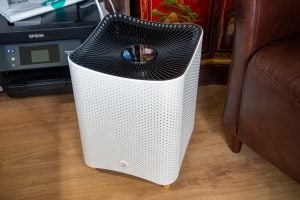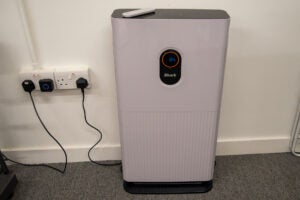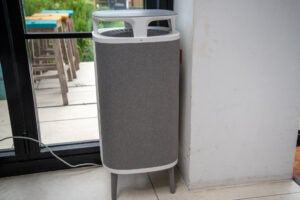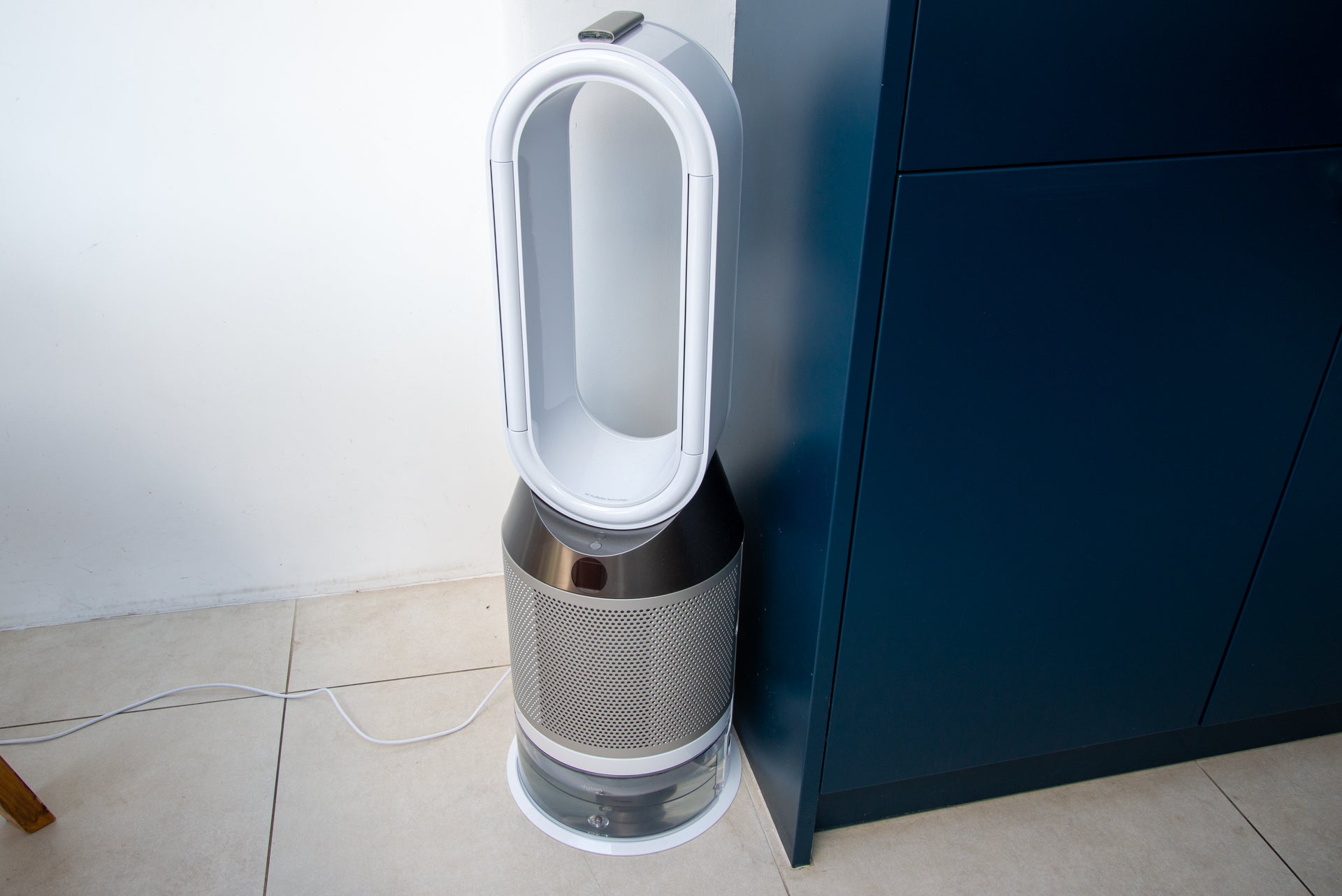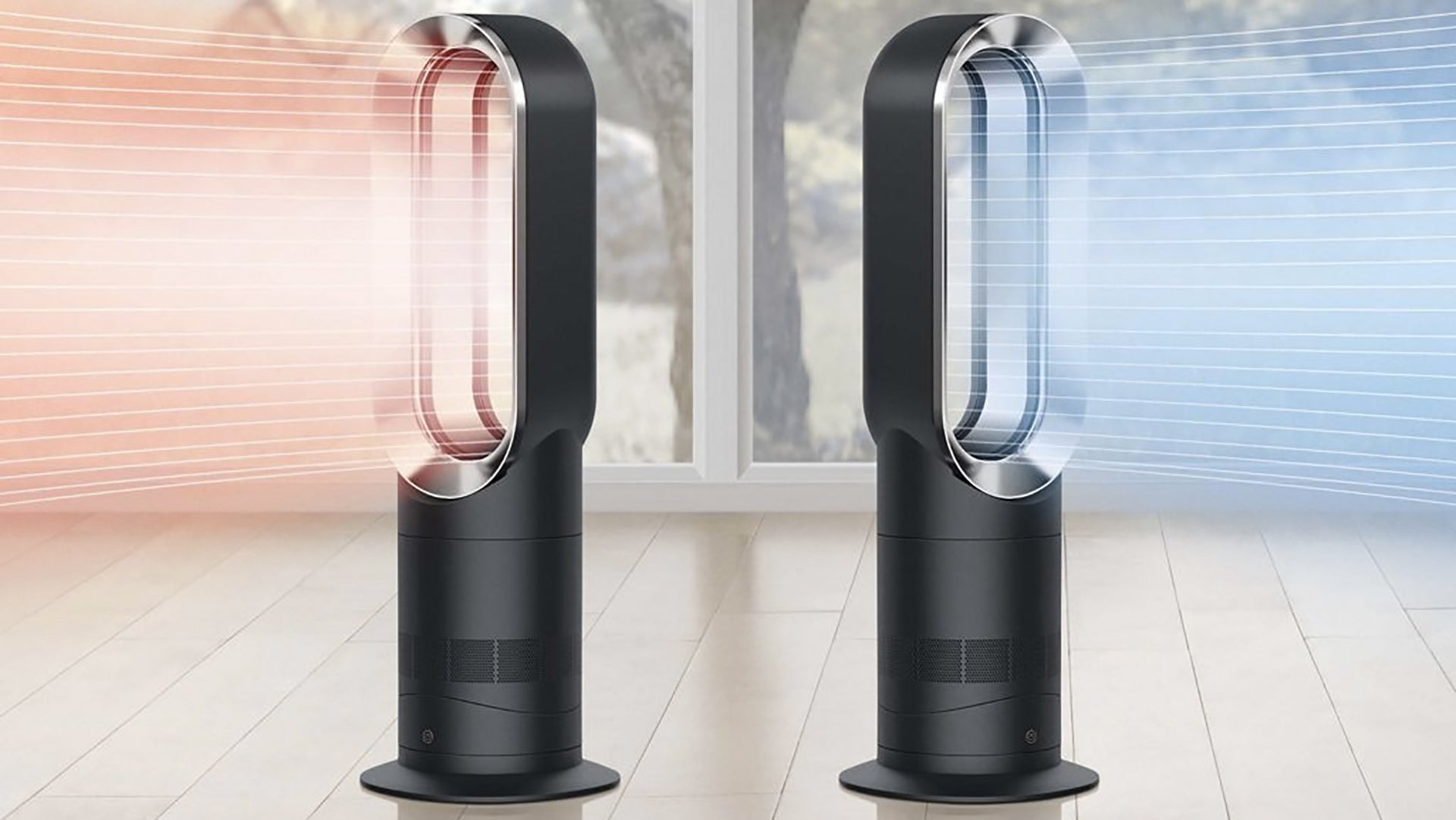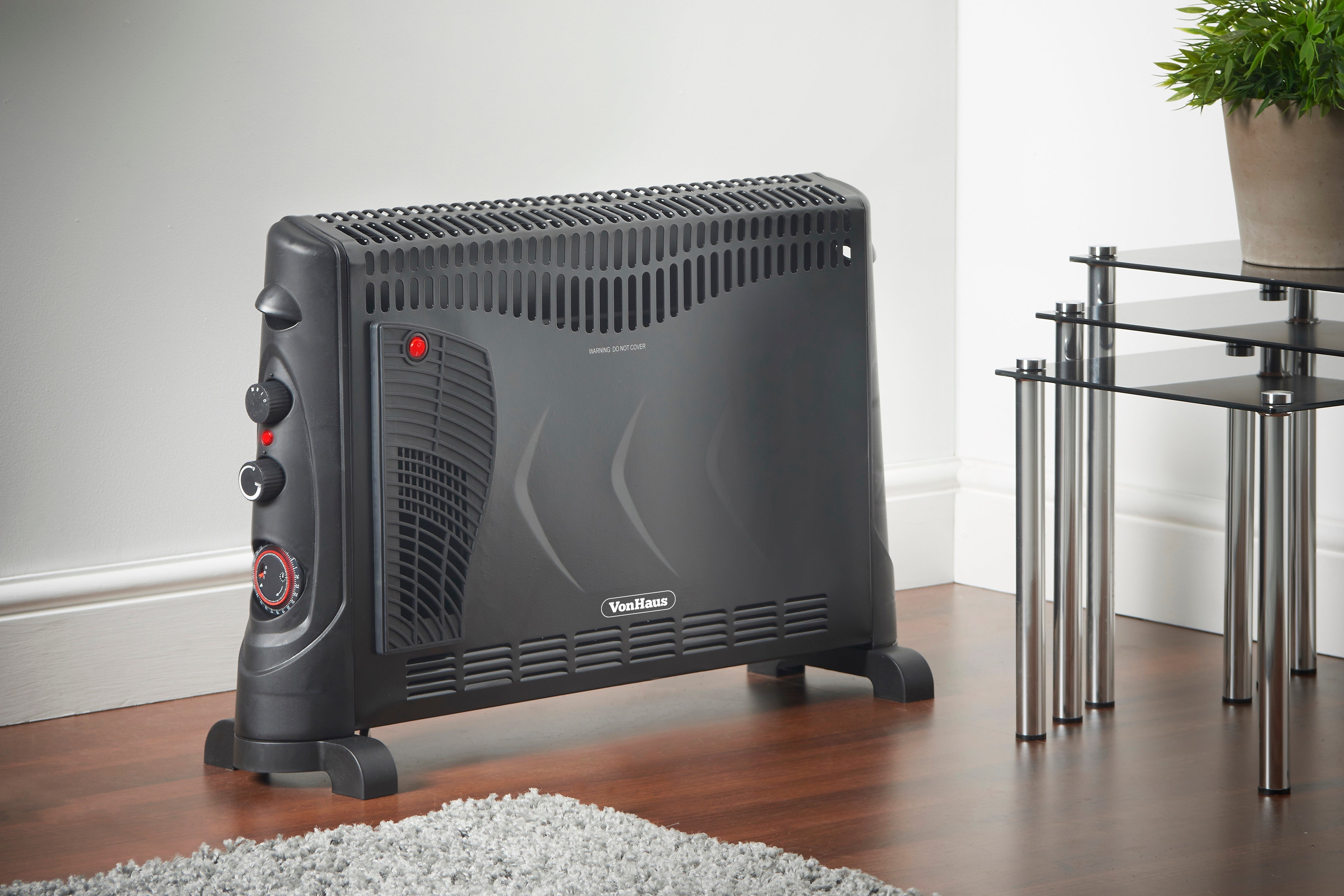Best Air Purifiers 2024: Our top picks for improving indoor air quality
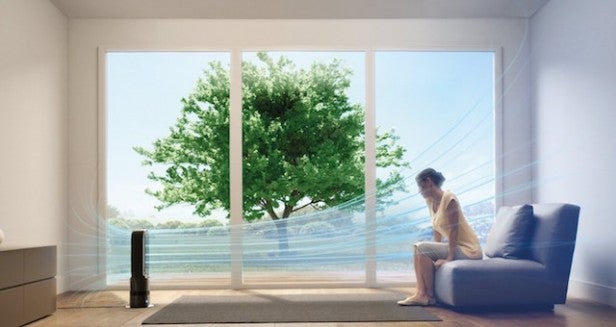
If you’re at all concerned about the quality of the air you breathe in at home, an air purifier could be exactly what you need to quell those worries.
While we’re all aware of how harmful air pollution can be outdoors, especially in cities, it can be easy to forget about the quality of the air that fills our homes. This isn’t just about pollution sneaking in through open windows – harsh cleaning chemicals, pet dander and pollen can all infiltrate your living space, causing you to breathe in harmful particles and allergens without even knowing it.
Thankfully, an air purifier can go a long way to cleaning up the air quality in your home, allowing you to breathe easy whether you’re working from a home office, relaxing on the couch in the evening or settling into bed. We’ve rounded up all the best air purifiers in this comprehensive best list.
Air purifiers are essentially fans that are designed to suck in dirty air, clean it using a filter and push it back out as clean air on the other side. Every air purifier on this list has been thoroughly tested by our team of reviewers.
We look at a variety of factors when reviewing an air purifier in order to measure its ability to clean air. This includes testing exactly how long it takes a purifier to remove test allergens and harmful particles from the air, as well as examining how simple that purifier is to assemble and use.
We also look at how reactive the air purifier is to a variety of particles. Cheaper purifiers might only monitor for dust, while higher-end devices can pack a greater range of sensors allowing them to react to a wider range of particles.
Keep reading to discover all the best air purifiers available right now or visit our other best list for more great tech designed to keep your home clean or the air cool. This includes the best vacuum cleaners, the best steam cleaners and the best fans.
Best Air Purifiers at a glance
- The best overall air purifier: Dyson Purifier Hot+Cool Formaldehyde – check price
- The best air purifier for flexibility: Mila Air Purifier – check the price
- The best budget air purifier: Ikea Starkvind – check the price
- The best large air purifier: Shark Air Purifier 6 HE600UK – check the price
- The best air purifier for dust: Blueair DustMagnet 5440i – check the price
- The best compact air purifier: Beko Air Purifier with HEPA Filter and HygieneShield ATP6100I – check the price
- The best large air purifier: Levoit Core 600S – check price
- The best for mid-sized rooms: Levoit Core 400S – check price
How we test
To demonstrate the quality of cleaning, the majority of air purifiers come with Clean Air Delivery Rate (CADR) ratings for smoke, pollen and dust. The higher the score, the better the performance. And, the individual ratings help you choose the right purifier for your needs. However, not all manufacturers quote CADR ratings and, instead, quote the percentage of particles below a certain size: the higher the percentage and the lower the quoted particle size, the better.
Some – but not many – air purifiers are capable of removing Volatile Organic Compounds (VOCs) from the air, too. These are harsh chemicals that can be found in everything from old furniture to cleaning sprays. To test an air purifier’s performance, we use a three-second burst spray from a can of insecticide – a source of particulate matter and VOCs – directed into the middle of the room. With the air purifier placed in a corner running at maximum, we time how long the air takes to return to normal, using a separate air-quality monitor.
We also light a smoke pellet and time how long it takes until our Nest Protect tells us that the air is safe again.
We also test the sound levels of purifiers, running at minimum and maximum speeds from a distance of 1 metre.
- Works all year round
- Powerful purification
- Excellent smart controls
- Expensive
- Powerful automation modes
- Sensor controlled cleaning
- Cleans the air fast
- Choice of filters
- No voice control
- Can be slow to ramp up fan speed
- Funky design options
- Simple to use
- Cheap, smart upgrade
- Can be slow to ramp up fan speed
- No remote control with Ikea app
- Fast air purification
- Automatic mode
- Clear display
- No smart controls
- Only measures PM
- Smart design
- Dramatically cuts down on dust
- Quiet and powerful
- Slightly fiddly app
- Expensive filter replacements
- Fast purification
- Simple controls
- Compact shape
- Only responds to particulate matter
- High-volume, efficient air purification
- App control with smart features
- PM2.5 air quality sensor
- Quite expensive to buy and run
- No ultraviolet sterilisation
- High-volume, efficient air purification
- App controlled with smart features
- PM2.5 air quality sensor
- No ultraviolet sterilisation
- Pricey filters

Dyson Purifier Hot+Cool Formaldehyde
The best air purifier for all-year use
Pros
- Works all year round
- Powerful purification
- Excellent smart controls
Cons
- Expensive
Every time Dyson launches a new purifier, it seems to add more features to it. Arguably, the Dyson Purifier Hot+Cool Formaldehyde is the most useful product of the lot: it’s a fan, it’s a heater for the colder months of the year, and it’s also a purifier. New to this model is the formaldehyde sensor.
This detects the dangerous gas, which can be released by old furniture, and ramps up the fan speed. Inside the fan is a catalytic filter that turns formaldehyde into water and CO2; this converter never needs to be replaced.
Alongside this, there are sensors for PM2.5 and PM10 dust, VOCs and NO2. This combination of sensors, plus the filters to deal with harmful particles, makes the Dyson Purifier Hot+Cool Formaldehyde more responsive than much of the competition. Leave it running on Auto mode, and this purifier will ramp its fans more often, as it’s capable of sensing more things wrong in the air.
As with other Dyson products, this is a smart product, so you can control it with your phone, or voice via Amazon Alexa or Google Assistant.
Putting the Dyson Purifier Hot+Cool Formaldehyde through our tests, we found that it cleaned our room from the harmful particles generated by a smoke pellet in just 10m 39s: that’s faster than the older model and one of the best results from an air purifier that we’ve seen.
As a fan, it’s powerful to: 3.8m/s of airflow at 15cm on maximum, dropping to a gentle 0.69m/s on the quietest setting, delivering just a very gentle breeze. Heat mode ramps up the fan speed a little, but the onboard thermostat turns the fan off as soon as your desired room temperature has been reached.
The overall combination of quality cleaning, sensors and all-year-round use makes this the best overall air purifier, with only the price likely to hold some people back.
Full review: Dyson Purifier Hot+Cool Formaldehyde review
Reviewer: David Ludlow

Mila Air Purifier
The best air purifier for flexibility
Pros
- Powerful automation modes
- Sensor controlled cleaning
- Cleans the air fast
- Choice of filters
Cons
- No voice control
- Can be slow to ramp up fan speed
If there’s one issue we experience with most of the air purifiers we test, it’s that they’re not designed to meet your specific requirements. The Mila Air Purifier fixes that, and has a range of filters that you can buy, each designed for a specific job.
The Big Sneeze, for example, has an H13 HEPA filter designed to capture allergens, such as pollen. The Overreactor gives you hospital-grade H14 HEPA filter and 1.25lbs of carbon filter to extract gasses and VOCs, such as Formaldehyde. Finally, the Critter Cuddler has the Mila Sock, which picks up pet hair. Filters range in prices between $59 and $99 and last for six months.
Built like a piece of scandi furniture, the squat Mila Air Purifier looks great. You can just turn it on and let the auto mode – which uses a combination of PM, VOC and CO2 sensors to detect air quality and adjust the fan automatically – do its thing.
It’s by connecting the purifier to your Wi-Fi and smart app that you really get the main benefits from it, however. Here, you’ll find a load of smart modes. Bubble Boy mode lets the purifier rip, pushing its cleaning to maximum levels. Housekeeping Service ramps up to maximum when the purifier spots that a room is empty. Quiet mode drops fan speed when you’re in the room. Sleep mode turns off the screen and reduces fan speed during your set sleep time. The Turndown service ramps up an hour before you go to bed, again taking the timings from the bedtime you set in the app. Finally, Whitenoise mode throws out some soothing sounds from the fan while you sleep.
It’s a shame that there’s no voice control, and this purifier doesn’t support Alexa nor the Google Assistant.
Performance is good, too. Although the fan was a little slow to ramp up after I’d lit the smoke capsule, the Mila Air Purifier still cleaned my air in 10m 39s, which is similar to that of the Dyson Purifier Hot+Cool Formaldehyde.
A purifier only, the Mila Air Purifier is a great choice if you want lots of clever cleaning modes and the choice of filter to suit your specific needs.

Ikea Starkvind
The best budget air purifier
Pros
- Funky design options
- Simple to use
- Cheap, smart upgrade
Cons
- Can be slow to ramp up fan speed
- No remote control with Ikea app
Who wants an ugly air purifier taking up their homes? Well, nobody if we’re being honest. Hand it to Ikea to fix this problem, with the Starkvind. Designed to blend into your home, this model comes in two versions. The standard version (pictured) looks a bit like a drum, standing vertically on legs and decked out in black or white material.
Then, there’s the side-table version, which is the same unit, only it has a solid top and long legs, so it can be used as a sidetable. That’s the ultimate way to make an air purifier fit into your life.
Internally, the filter is in three parts: there’s a pre-filter that you can vacuum of larger particles, such as hair, then two filters that can’t be cleaned, with one for gasses and odours and one for particles. Replacements cost a reasonable £27 and should last for around six months.
The Ikea Starkvind can be controlled via the simple dial on top. Turn it to a manual fan speed (one to five) or use the auto mode, which uses a PM sensor to watch for dust. That makes this purifier a little less responsive than the Dyson Purifier Hot+Cool Formaldehyde, which has a greater range of sensors, so can respond automatically to more threats, during our tests.
If you have an Ikea Tradfri Gateway, you can hook the Starkvind up to your home network and control it via the app, including setting schedules as well as taking manual control. There’s, bizarrely, no option for remote control through the Ikea app, although you can add this functionality by switching to HomeKit control.
Performance was good in our tests: our smoke pellet was cleared out in 11m 57s, although it took a full 25m until the app reported that the air was fully clean. This purifier was also a little slow to ramp up fan speed to full in order to deal with the smoke.
If you mainly want to deal with small particles, such as dust and other allergens, then the Ikea Starvind is a neat air purifier that will blend into your home.
Full review: Ikea Starkvind
Reviewer: David Ludlow
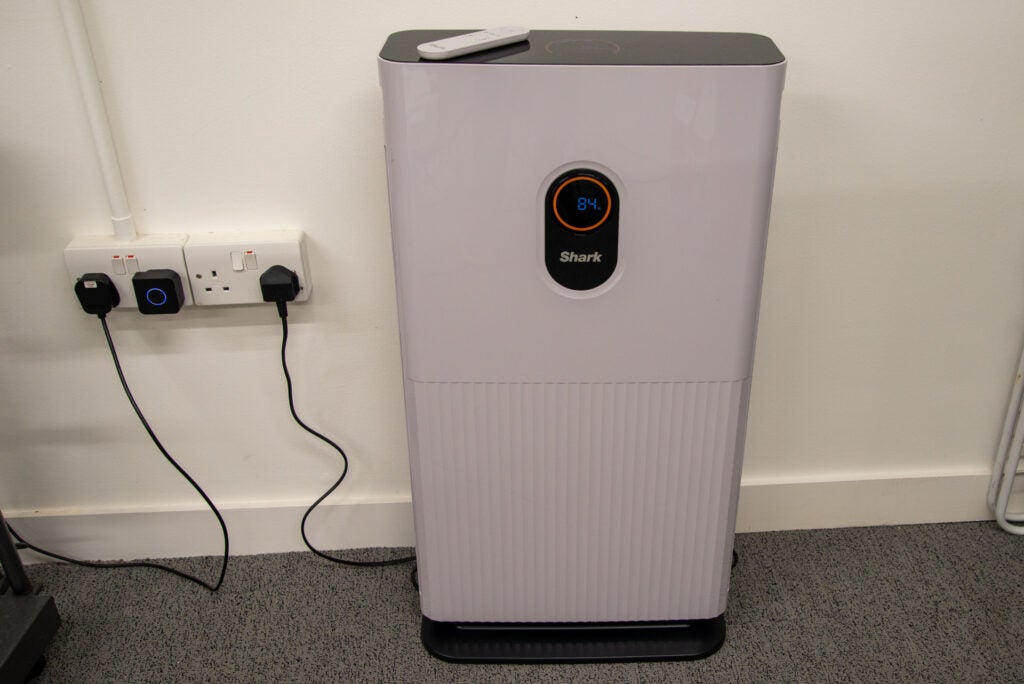
Shark Air Purifier 6 HE600UK
The best large air purifier
Pros
- Fast air purification
- Automatic mode
- Clear display
Cons
- No smart controls
- Only measures PM
There’s no messing about with the Shark Air Purifier 6 HE600UK: it’s a huge air purifier, with a massive filter and lots of fans, designed to clean the air quickly. Filters should be replaced every 12 months (or when the filter light turns on) and cost a reasonable £69.99 each.
The Shark Air Purifier 6 HE600UK doesn’t have any smart features, and everything is controlled via the remote control. This can sit on top of the purifier, although a magnetic mount would make it easier to store without risking of losing it.
The filter can absorb small particles (99.7% of those down to 0.3 microns), odours and VOCs. However, there’s only a PM sensor in this machine, so it will only respond and ramp up fan speed automatically when it detects smaller particles. If you want a more responsive air purifier, the Dyson Purifier Hot+Cool Formaldehyde is a better choice.
Air quality is shown on top, running from 100% (the best) and dropping down. In auto mode, the purifier will turn off automatically once the air is clean, saving power.
We tested the Shark Air Purifier 6 HE600UK by lighting a smoke pellet. It took just 6m 30s for the Nest Protect to say the air quality was good, and only 9m 46s for the air purifier to show full air quality again. Both are very fast results.
If it’s mostly dust particles and allergens, such as pollen, that you want to deal with, this air purifier is very fast. However, it’s very large, taking up a lot room.
Full review: Shark Air Purifier 6 HE600UK review
Reviewer: David Ludlow

Blueair DustMagnet 5440i
The best air purifier for dust
Pros
- Smart design
- Dramatically cuts down on dust
- Quiet and powerful
Cons
- Slightly fiddly app
- Expensive filter replacements
The Blueair DustMagnet 5440i is so called, as it’s designed to suck dust out of the air and reduce the amount of vacuuming you need to do.
It’s a stylish choice. The 5440i is draped in a soft material finish and comes in either white or grey; on top of the purifying unit itself is a small tray, which turns it into a nifty side table.
This purifier also comes with two filters, one at the top and one at the bottom, and a mesh pre-filter for dealing with larger particles and hair. The internal filters themselves are said to trap dust, VOCs, smoke, pet dander and bacteria and viruses, and can be replaced – Blueair say they should last for six to 12 months, although you will get alerts through the app that says when they need to be replaced. These aren’t HEPA filters here, but ones that Blueair assures are just as effective.
To go with the basic controls for fan speed and a mode switch, the 5440i is a smart purifier that connects to WiFi and works with the Blueair app; the app allows you to turn down the ambient lighting on the purifier, as well as assigning different products to locations around your house, if you’ve got more than one Blueair product at home.
In addition, there’s also a wider choice of manual fan speeds than with the physical controls, and the ability to schedule the purifier’s operation, which we found especially useful, given the purifier will only capture dust and dirt when it’s on. The app also displays the current quality and the level of PM2.5 in the air, and if you want to control the purifier with your voice, it can also work with Amazon Alexa.
In placing the 5440i in a particularly dusty spot at home, we found the purifier to be rather efficient and we had to vacuum far less often. When running our standard tests, Blueair’s stylish candidate also performed admirably with it removing pollutants caused by a smoke capsule in 6m 43s, which is rather quick. The noise level of the 5440i is also comparatively quiet on all settings, with 58.96dB at its highest setting. If you want to reduce how dusty your home is, this is a stylish way to do so.
Reviewer: David Ludlow
Full review: Blueair DustMagnet 5440i review

Beko Air Purifier with HEPA Filter and HygieneShield ATP6100I
Best compact air purifier
Pros
- Fast purification
- Simple controls
- Compact shape
Cons
- Only responds to particulate matter
If you’re searching for a smaller air purifier, the Beko Air Purifier with HEPA Filter and HygieneShield ATP6100I has a compact shape, offers fast purification and is easy to use.
The ATP6100I is tall and cylindrical, making it stylish enough to display but not so big that it dominates a room. This particular air purifier is designed to be used in rooms up to 24m² and Beko also offers a smaller version for rooms up to 13m².
There are three filters inside the purifier – a vacuumable pre-filter to pick up larger items like pet hair, a HEPA 13 filter to take care of smaller particles like dust and pollen and a carbon filter to remove odours from the air.
The ATP6100I can be controlled using the touch buttons on the front, with three manual speeds to choose from and an automatic mode that detects the level of dust particles in the air using a built-in dust sensor. If you want a purifier that can respond to more environmental factors than just dust, you may want to consider the Dyson Purifier Hot+Cool Formaldehyde.
There’s a status light to indicate air quality, a Sleep mode to switch the light off at night and a timer with two, four and eight-hour options, allowing you to clean the air in your room before you doze off.
We tested the ATP6100I by lighting a smoke pellet and found that it took six minutes and two seconds for the Nest Protect to announce that the air was good to breathe again. That’s exceptionally fast at almost double the speed of the Ikea Starkvind and similar to the Blueair DustMagnet.
If you want a simple and effective air purifier and are not overly bothered about smart controls or additional sensors, the Beko Air Purifier with HEPA Filter and HygieneShield ATP6100I is a great choice.
Reviewer: David Ludlow
Full Review: Beko Air Purifier with HEPA Filter and HygieneShield ATP6100I

Levoit Core 600S
The best large air purifier
Pros
- High-volume, efficient air purification
- App control with smart features
- PM2.5 air quality sensor
Cons
- Quite expensive to buy and run
- No ultraviolet sterilisation
If you’re looking for an air purifier that’s powerful enough to efficiently handle a large living space then look no further than the Levoit Core 600S. Designed for rooms of up to 1580 square feet, the Core 600S has a HEPA 13 filter that works quickly to remove pollen, mould spores and even viruses from the air.
From our tests, we concluded that this is simply one of the best performing air purifiers we’ve used. We found that the Core 600S brought the high 999μg/m3 air quality measurement down to a ‘very good’ rating two minutes faster than any other air purifier we’ve tested.
We also found that although large, the Levoit Core 600S is still fairly quiet, peaking at just 50.4dBA at full speed.
The Core 600S is also an incredibly easy device to use and requires minimal setup, especially with the accompanying VeSync smartphone app, which allows you to control the Core 600S remotely.
Onboard the device you’ll find a control panel that includes easy-to-see buttons for power, locking the keypad or setting a timer. The control panel lets you choose from four fan speeds, an ultra-quiet mode which is perfect if you plan on using this while sleeping in the same room, and Auto Mode.
Auto Mode is particularly useful as it detects the level of pollutants in the air and adjusts the fan speed accordingly. It does this by using a laser-based system that scans the air.
It’s worth considering that although powerful, the Levoit Core 600S is quite an expensive model and does require replacement filters once or twice a year. It might be best to avoid this one if you don’t have larger rooms in need of air purification.
Reviewer: Simon Handby
Full review: Levoit Core 600S

Levoit Core 400S
The best for mid-sized rooms
Pros
Cons
Designed for mid to large sized spaces up to 890 square feet, the Levoit Core 400S is ideal for areas such as open-plan kitchens and living rooms.
With a HEPA 13 filter (also found in the larger Levoit Core 600S), pollen, mould spores and viruses can be removed from the air. The Core 400S is also equipped with a built-in particulate sensor, which can detect if air quality decreases before increasing the fan speed accordingly, thus activating the device’s auto mode.
The Core 400S is easy to use, thanks to both the on-device control panel and the accompanying VeSync smartphone app. The control panel has a clear numerical display that shows the current air quality reading, so you can easily check on the room’s air quality.
On the control panel, you’ll also find buttons for choosing one of four manual fan speeds, night mode which quietens the device and lowers the fan power, alongside a timer and a lock function to stop others from adjusting the settings.
The VeSync app connects the Core 400S to your wireless network and gives you access to more features, data and settings, including schedules to start or stop the Core 400S at convenient times.
We found that the Core 400S performed well in our tests, taking just 10 minutes to bring down the maximum 999μg/m3 air quality reading to a ‘good’ air quality reading, with one extra minute bringing it further down to a ‘very good’ 8μg/m3 reading.
One key factor to keep in mind is that you will need to change filters on this once or twice a year, which costs around £60 each time.
Reviewer: Simon Handby
Full review: Levoit Core 400S
We also considered…
FAQs
Air purifiers use a fan to pull in dirty air at one end, remove pollutants, and output clean air at the other end. The exact pollutants that can be cleaned depend on the technology used. All of the air purifiers we’ve tested here use a HEPA filter, which will capture a minimum of 99.97% of airborne particles 0.3µm in size. Also known as particulate matter, these particles can penetrate your lungs causing respiratory problems, particularly in allergy sufferers.
Particulate matter sources include dust, with cleaning likely to disturb dust and throw it into the air, pet hair and dander, smoke and pollens. HEPA filters are no good where dust has settled, since the filters can remove only airborne particles. In other words, you still need to clean effectively. HEPA filters also have a lifespan, after which they’ll need to be replaced. The exact timing will depend on the air purifier and how dirty your air is, but expect to buy a new filter between three months and 12 months of operation.
Volatile Organic Compounds (VOCs) are harmful chemicals that are often found in cleaning products, paints, and some beauty products. VOCs are also found in some manufactured products, such as synthetic carpets and old furniture. Most air purifiers can’t touch these pollutants; those that can, can’t filter all VOCs.
Instead, you’re better off with an air monitor, such as the excellent Foobot, to monitor your home to see what’s giving off VOCs. Where possible, switch to less harmful products. Some models of air purifier also have an ionisation option. These use negative ions, which causes particles to stick to surfaces – such as wall or floor. Ionisation has been shown to reduce the risk of some viruses. Ionisation on its own isn’t particularly effective, so always combine with a proper air purifier.
All air purifiers use a fan of some description, so look for one that runs quietly enough for your intended use. We measure sound at maximum and minimum settings to help you choose. An automatic mode that ramps up the fan when the purifier detects dirty air is useful, as you can leave the purifier to do its job. You need to match the air purifier you buy to the size of room or space that you want to keep clean. Purifiers are rated by the square metre, so buy one that’s big enough.
Finally, you can look out for the Clean Air Delivery Rate (CADR), which tells you how effective the purifier is at different types of allergen, compared to introducing clean air. For example, an air purifier with a CADR score of 190 for dust particles is as effective as adding 190 cubic feet of clean air per minute. In short, the higher the CADR rating for each type, the better. And, CADR scores are comparable across all products, helping you make the right choice.
CADR has three main ratings to help you decide: smoke uses very small particle sizes of 0.09 to 1µm; dust has particle sizes of 0.5 to 3µm; and pollen uses particle sizes of 5 to 11µm. It’s best to choose your air purifier based on how effective it is at the pollutant you want to remove. Hayfever sufferers, for example, should choose an air purifier that’s efficient for pollen removal.
Finally, since air purifiers come in different sizes, the CADR rating should equal (or exceed) 2/3 of your room size in square feet. A 135-sqft room would need CADR ratings of 90 or above, for example
Trusted Reviews test data
You can see a breakdown of the test data we collected reviewing all the air purifiers in this list. The main metrics you should look for are sound and how quickly it cleaned up a smoke pellet during our checks.
Comparison specs
You can see a full breakdown of all products mentioned in this guide’s specs in the table below.



